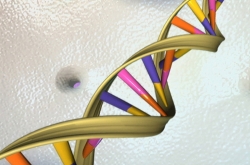
Researchers at Brookhaven National Lab (BNL) are studying how radiation affects DNA, specifically a tumor-suppressor protein called p53, which deploys cell repair efforts. | Photo courtesy of National Institute of Health.
Researchers at Brookhaven National Lab (BNL) are studying a tumor-suppressor protein called p53 to further the Office of Science’s long-standing mission to understand how radioactive materials affect the human genome.
DNA is not simply the stuff of inheritance: it is also a sort of instruction manual for the body. If an individual’s genome -- their entire set of DNA -- were a volume of books, then each book in the volume would be their DNA and each page in each book would be their genes. The instructions on a specific page tell a specific cell what protein to produce so it can carry out a specific task -- whether that task be day-to-day or damage control.
Stresses on a cell, even low doses of radiation, can damage DNA, obscuring the instructions and making cells behave dangerously. These types of mutations can cause genetic disorders or cancer.
The p53, a tumor-suppressor protein, affects how the cell responds to damage, whether by turning on a repair effort, stopping the cell from dividing, or even telling the cell to self-destruct to stop the damage from multiplying any further, as uncontrolled cell division leads to tumors. The p53 protein prevents tumors from forming, but it doesn’t prevent damage to DNA from being done.
P53 performs this important task by attaching to different points on the DNA -- and then telling different sets of genes to perform tasks that ensure proper proteins enter the cells at times of stress. At least that’s how it’s supposed to work.
Recently, a team of BNL researchers led by Krassimira Botcheva produced the first high-resolution map of p53 binding sites in healthy human cells, and contrasted it with p53 binding sites for cancerous cells. They found two key differences. First, the healthy cells have p53 binding sites near the start site for genes that affect processes like DNA repair, stress response and cell survival, while cancerous cells have p53 binding sites far from those critical genes.
Second, BNL scientists discovered that p53 binding sites in healthy cells tend to be in places called “CpG islands,” and that is exciting news because these islands are special places in the human genome with important functions -- they regulate the way genes are expressed. In healthy cells these islands have lesser amounts of a special chemical tag known as a methyl group (which typically serves as a “stop” button for genes, and thus the making of their proteins). This is a fascinating finding because it may explain why, in cancer cells, p53 is away from genes and CpG islands, as they receive more of those methyl tags during tumor development.
It’s not yet clear how those changes make such a stark difference between sickness and health, but it does provide a framework for solving the mystery.
You can learn more about Brookhaven National Lab here and on the Energy Department’s Office of Science here.




